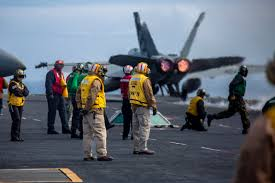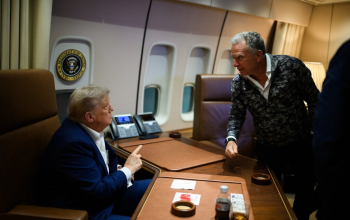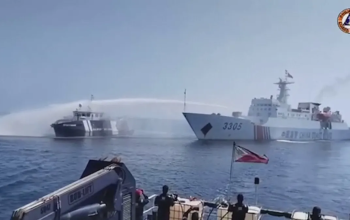Over the course of nine days, from the Gulf of Alaska out through the Aleutian Island chain, in the air, on land, and at sea, the ABECSG demonstrated the full power and capability of a U.S. Navy carrier strike group. The 5,000 Sailors and Marines of the ABECSG successfully completed a variety of exercise events across multiple domains, leveraging the unique capacity a CSG brings to the joint force.
Flagship Abraham Lincoln, with the embarked CSG-3 staff, served as the command and control hub for the strike group, directing operations across a multi-dimensional battlespace hundreds of nautical miles wide. The ship hosted Adm. Christopher Grady, Vice Chairman of the Joint Chiefs of Staff; U.S. Senators Lisa Murkowski and Dan Sullivan, and other military and civilian leaders from across Alaska and the U.S. government, reaffirming the strategic importance of aircraft carriers in signaling U.S. resolve and operational reach.
“I am incredibly proud of the Abraham Lincoln crew and their performance throughout Northern Edge,” said Capt. Daniel Keeler, commanding officer of Abraham Lincoln. “This has been a demanding but incredibly rewarding opportunity. Operating in Alaska alongside the joint force and our Canadian allies, we displayed not only our ship’s unique capabilities as the flagship of the world’s most powerful carrier strike group, but also the dedication, technical acumen, and strength of Lincoln Nation.”
Sailing alongside Abraham Lincoln were three Arleigh Burke-class guided-missile destroyers, fulfilling a variety of roles over the course of the exercise. Complicated scenarios at sea demanded professionalism, skill, and expertise from these crews. They performed admirably, sustaining maritime superiority in an integrated maritime domain.
“Northern Edge offered an invaluable opportunity for our ships and crews to refine the full spectrum of surface warfare in a challenging and geographically strategic location,” said Capt. Allison Christy, commanding officer, Destroyer Squadron (DESRON) 21. “Our destroyers demonstrated the readiness, lethality, and teamwork required to fight and win as part of a carrier strike group, alongside our counterparts across the joint force.”
Taking place over a vast expanse of territory around Alaska, including the Joint Pacific Alaska Range Complex (JPARC), Joint Base Elmendorf-Richardson, Eielson Air Force Base, and Dutch Harbor, among others, this exercise emphasized both the ability to project power far across the Pacific and the capacity to defend the home front.
A variety of scenario events undertaken by Carrier Air Wing (CVW) 9 were integral to reinforcing the strike group’s ability to deliver effects throughout the exercise area. Aircraft from CVW-9, ABECSG’s embarked air wing, performed defensive counter-air, maritime strike missions, and expeditionary advanced base operations across the Alaskan waterspace and the Aleutian Islands. In the skies above and around Alaska, CVW-9 logged over 3,000 flight hours and more than 1,100 sorties in support of exercise requirements.
“This exercise tested the SHOGUN Warriors of CVW-9 in a wide range of demanding missions, from long range maritime strike to operating in an expeditionary manner forward deployed in Alaska’s challenging conditions,” said Capt. William “Tank” Frank, Commander, Carrier Air Wing NINE. “The professionalism and adaptability of our team proved once again that this Air Wing is ready to deliver combat power anytime, anywhere, no matter how contested the environment. The many hours of tactical flying don’t reflect all of the mission planning, aircraft maintenance, and preparation our aviators and maintainers put forward to accomplish our objectives. The Naval Aviation team continues to set the standard for responsiveness and warfighting excellence.”
For 250 years, America’s Navy has operated across the globe in defense of freedom and economic vitality. Today, carriers like Abraham Lincoln remain unmatched in mobility, endurance, and combat capability and are symbols of U.S. maritime power, resilient presence, and national security. These symbols were on full display during Northern Edge, and exemplify what the U.S. Navy offers to the joint force and our network of partner and allied nations.
CSG-3 participants in Northern Edge included Abraham Lincoln, Destroyer Squadron (DESRON) 21 staff, Arleigh Burke-class guided-missile destroyers USS O’Kane (DDG 77), USS Michael Murphy (DDG 112), and USS Frank E. Petersen Jr. (DDG 121), and the nine squadrons of CVW-9, including an F-35C Lightning II squadron, the “Black Knights” of Marine Fighter Attack Squadron (VMFA) 314; three F/A-18E/F Super Hornet squadrons, the “Tophatters” of Strike Fighter Squadron (VFA) 14; “Black Aces” of Strike Fighter Squadron (VFA) 41, the “Vigilantes” of Strike Fighter Squadron (VFA) 151; the “Wizards” of Electronic Attack Squadron (VAQ) 133, operating the EA-18G Growler; the “Wallbangers” of Carrier Airborne Early Warning Squadron (VAW) 117, operating the E-2D Advanced Hawkeye; the “Chargers” of Helicopter Sea Combat Squadron (HSC) 14 operating the MH-60S Sea Hawk; and the “Raptors” of Helicopter Maritime Strike Squadron (HSM) 71, operating the MH-60R Sea Hawk.
Northern Edge 2025 is an exercise led by U.S. Indo-Pacific Command that serves as a platform for joint, multi-domain operations to deliver high-end, realistic warfighter training, strengthen joint interoperability, and sharpen the air and sea-based combat readiness of U.S. and participating forces.




